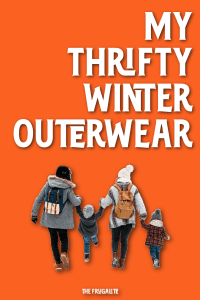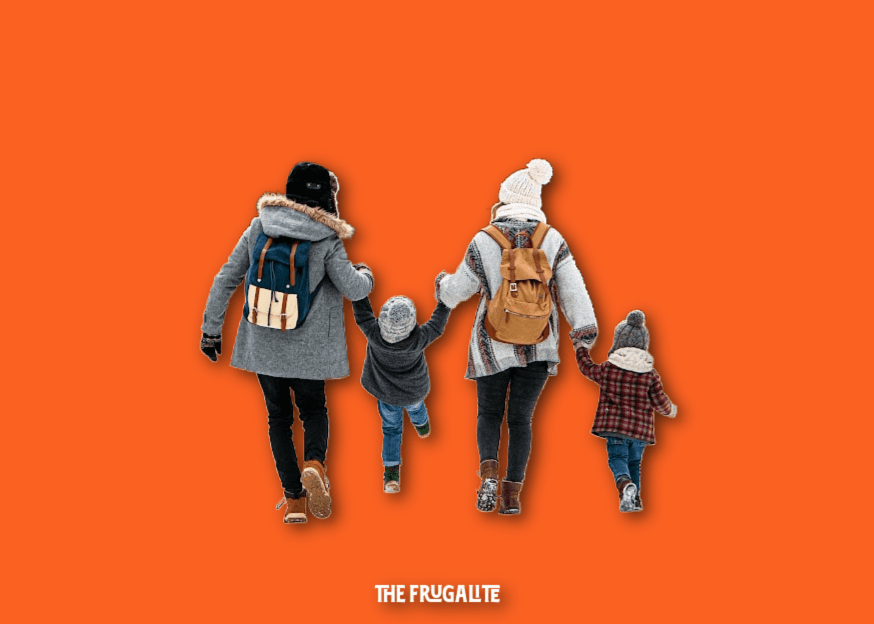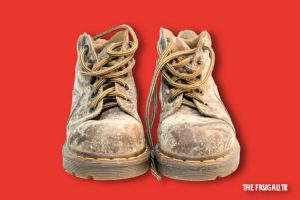(Psst: The FTC wants me to remind you that this website contains affiliate links. That means if you make a purchase from a link you click on, I might receive a small commission. This does not increase the price you’ll pay for that item nor does it decrease the awesomeness of the item. ~ Daisy)
By the author of the FREE online course Growing Self-Sufficiency: The Whole Picture
If you were to go to an outdoor store in your area, you might get the impression that getting winter outerwear for activities outside would cost you a bundle. Taking a look online at one of our popular outdoor clothing suppliers in Canada, I found that they were selling socks for no less than $22 to $33 a pair. That’s right….for one pair!
Heading out for another shift of snow shoveling here on the homestead, I was feeling pretty proud of my thrifty winter outerwear. I thought I would share my simple recipe for dressing for the great Canadian outdoors in the cold months.
And I’m not talking about just running from the front door to the remote-started-warming-up car, either! I’ll share how I dress for being active outside, including cross-country skiing across a frozen river in minus 30 Celsius and high winds, or how about what I have worn when building my own snow quinze to sleep in. Yep, a winter home made of snow, made by yours truly! As well, I have a few secrets to share about how I got my stuff for next to nothing!
As I know that we have Frugalites living in all different types of winters, I am looking forward to learning more about how you dress and save in your own local climate.
Winter outerwear begins with underwear!
The first step in preparing to go outside is the base layer. I cannot emphasize the importance of this layer. Wear the wrong stuff, and you’ll be sweaty, wet, and cold in no time. Wear the right stuff, and you can complete heavy tasks outside without suffering at all. (OK, it’s still hard work, but you won’t get a chill).
In my own experience, I have not found a better base layer than pure merino wool. Objections to this might include finding wool itchy. While I do find some forms of wool itchy and scratchy, I have not found this with Merino. If I am preparing to do shoveling outside, then you will find me wearing long johns and a top made of pure Merino wool. My top comes up slightly on my neck, not to a full turtleneck, but enough to protect a bit.
My surprising snow pants
For all dry shoveling, where it is below freezing and not raining out, I wear my funny snow pants. You won’t find these in any outdoor store! They are ancient running pants called “tearaways” with snaps on the side to take them off quickly. However, that is not the feature that makes them valuable to me. They are made of a polyester-type fabric that is still breathable, and they have a light cotton lining. I have found that they are the perfect, breathable outer layer for all my winter activities where I am not actively lying in the snow. I believe that these pants could be around 20 years old. A quick search online found that they are, luckily, still made today
An example of layering for heavy outdoor work
Outdoor work or exercise varies in degrees. How I dress will, therefore, vary. The other factor that has an impact on my dress is how high the wind is. Here are a few examples of how I would dress. Keep in mind that you are going to be cold until you get moving:
Shoveling in low winds and below freezing. On top of my base layer and snow pants, I would only add a light top. In most cases, this would be a light to medium fleece. I do like my neck to be covered, so I would have a soft wool scarf on and a pretty thick wool hat with ear flaps that tie under my chin.
Shoveling in more extreme cold and higher winds. On top of my base layer and the same snow pants (which provide decent windbreaking), I will add a heavier pure wool knitted sweater. I have found that this breathes well during heavy work. I will wrap my scarf around my face and tie my ear flaps.
Quinze building. Digging out a snow pile to make a snow home is heavy and tight work that requires you to lie on the ground surrounded by snow. When you are away from home and there is no place to warm up except the fire you build, it is especially important not to overheat and get a chill. I lie on a doubled-up yoga mat for some insulation. I wear only my base layer, plus a breathable outer suit, like foul weather gear for sailing. I dig only for short times to avoid heating up and then take a break. This is less important when building my quinze at home, but worth keeping in mind. If you are doing this as a team, people can dig in shifts and then sit by the fire.
Cross Country Skiing in Extreme Low Temps and High Winds: I spent one winter skiing on the frozen river I lived beside, skiing across and back most days a 6km round trip. We had a record-breaking cold snap that winter and very high winds. I added to my regular gear a complete balaclava. To protect my face, I would wrap a loosely knitted scarf all around my head. The loose weave allowed my breath to get through and wouldn’t fog my glasses. I added a light fleece on both top and bottom and then a wind-breaking layer on top of that. This allowed me to ski comfortably down to -30 Celsius, lower with wind chill (below -20 Fahrenheit).
I will adjust the outfit as required. Even with my experience, I sometimes need to take it a step down. Especially if I find I am getting hot, I will immediately go back in the house to switch to a lighter top, say, from my wool sweater to a lighter fleece. If the wind is very high, I may add my breathable rain jacket on top of that.
Footwear
For all outdoor activities, except skiing and skating, I wear the same heavy rubberized winter boot with insulating removable felt liners. The boot comes up above mid-calf with a faux fur ruff. By wearing a heavier wool sock with these, I am good for basically any temperature I encounter here. Keep in mind that I am always on the move! If I were winter hunting in a tree stand, for example, I would bring some foot warmers with me, for sure!
How to get winter outerwear for less

Another way I can get better deals, even in thrift shops, is by shopping for winter outerwear in the summer or at the end of the season. One time, I found a beautiful pure merino wool light base layer top on the long-sleeved shirt rack in the off-season. The person who had tagged it had no idea what it was. While retailing for $75 to $100 new, I was able to grab this top (and I did grab it!) for less than $10. For backups, I have found some merino blend tops that are quite serviceable and very warm, too.
The other way I source my outerwear is to ask for it as gifts. Whenever the holidays roll around, my sister knows that I would love to add another high-quality merino item to my base layer. Because I rely on my outerwear for so much of the year, those close to me know that it is my favorite gift!
Staying warm by dressing and shopping smart
Many people believe that functional outerwear has to be expensive. Could you see yourself trying any of the thrifty tips offered here? Do you have one you can share with us? Please tell us in the comments below.
About Colette
Colette is passionate about sharing her knowledge of thrifty living and self-sufficiency. She has developed her skills in self-reliance living in the suburbs, the city, and more recently, on her own Half-Acre Homestead. Colette lived five years completely off-grid and without running water in an eight by 24 foot tiny home while designing and building her own 18 by 24-foot eco-cabin. Her website, Half Acre Homestead is attracting followers from around the world who want to become more self-sufficient. Colette invites you to stop by the Homestead and check out all of the great resources including the practical How To Guides, A Tiny Home Resource Center and her organic gardening stories on her blog. She shares her wholistic model (body/mind/spirit) for achieving self-sufficiency in her Free Course, “Growing Self-Sufficiency: The Whole Picture.” Stop by the Homestead today to register free of charge!











4 thoughts on “My Thrifty Winter Outerwear”
I’ve basically never had proper “winter wear” and have often been in cold situations. Layering has saved me every time. Using cotton and wool when available, keeping as dry as possible, and keeping your head and feet warm are top priorities. I remember when I used to stuff my boots with newspaper for added insulation, it helped. When I was camping in Nevada and the weather turned bitter cold (well below freezing), I was really gad I was a fan of Russian culture – because I’d acquired a Navy ushanka and that may have saved my life. The fur, even though fake (it was an enlisted man’s ushanka and they didn’t rate real fleece), really helped keep the heat in and the ear flaps kept my noggin warm. The suggestions above are far better.
Hi Redbranch, Thanks for teaching me about a ushanka! When I read your post, I didn’t even know what one was. I can see how having one, even a fake one, would have been helpful. It sounds like you’ve had some wonderful experiences camping and enjoy nature, as I do. Wishing you a wonderful year with lots of time in nature!
I love merino wool! I have several items, all 100% merino. Oddly enough, I have one solitary sweater that itches like mad. None of the others do. That sweater not a base layer, so I’m currently considering a cotton turtle neck in a compatible color to wear under it for cold weather. Also, I have a set of thin silk long underwear – which adds a gentle layer of insulation. Because silk is breathable and very smooth, it might be a good option to wear under warmer wool for those who find wool too itchy. Thrift shops and resale shops can be a treasure trove! When I lived in England years back, I found a beautiful red jacket 85% new wool and 15% cashmere with a heavy acetate lining for £3.00! (Approximately $4.50 american.) I’ve had it now for 20 years, and it is still a pleasure to wear.
Hi Deb, I’m glad to hear from a fellow merino wool lover! Thanks so much. I was interested to read about your experiences with silk. I have never had any silk long underwear. I will keep an eye out in the thrift shops for some in the coming year. That red jacket sounds wonderful. Isn’t it amazing how long a well-made item can last? Wishing you a warm and cozy rest of the winter and a great year!